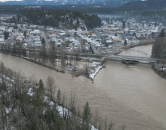Stay informed
Carney Promised Defiance. All We’re Getting Is Deference
Nearly seven months after an election that returned a minority Parliament and a government led by the Liberal Party with Prime Minister Mark Carney at the helm, Canadians would be forgiven for asking what they’re meant to be doing with their elbows.
During the election, the Liberals ran on elbows-up nationalism, striking a defiant posture in the face of tariff and sovereignty threats from United States president Donald Trump. Carney never promised to solve every problem on day one, nor did he promise to utterly pacify Trump, whom he’s cited both as “transformative,” with all the ambiguity attending the word, and unmanageable.
Carney knew he couldn’t control Trump, only Canada’s response, which would entail foreign trade diversification and domestic nation building by way of infrastructure projects and internal trade. It was an entirely reasonable approach that’s already yielded welcome strategic overtures. For instance, the government is hoping to reset its trade relationship with China and to build deeper relationships with other Asia Pacific states and Europe.
But standing up to Washington has, so far, meant mostly giving in. Since Trump’s talk of making Canada the “cherished” fifty-first state, Liberal governments under Justin Trudeau and Mark Carney have dropped retaliatory tariffs against the US, abandoned the digital services tax hated by Republican and Democratic administrations alike, committed to increasing military spending at American behest (including possibly sticking with US-made F-35 fighter jets, and the HIMARS missile system), discussed joining an American-led missile defence scheme, securitized the border in response to bogus claims from the Trump administration of fentanyl smuggling, and allowed US oil companies to extract record-setting profits from Canadian resources.
If that seems like a lot, well, there’s more. Canada has considered allowing American access to the sacred cow of the Canadian dairy market and, this summer, oversaw a Canadian investment binge of spending into stateside capital markets—including big money that went south from the Canada Pension Plan. Now, we learn that Carney apologized for a television ad placed by Ontario premier Doug Ford that ran on US networks, using former president Ronald Reagan to attack Republican tariffs on Canada.
We ought to know who we’re trying to placate. The Trump administration runs anti-immigrant raids and disappears citizens and non-citizens from its streets, commits air strikes against Venezuela, rejects the boundaries of rules of engagement for its military, extorts trade partners, funds its armed forces during a government shutdown with private donations, starves its people, sets itself up to potentially interfere in elections, prosecutes its political enemies, and threatens professors.
Yet despite all this, Ottawa’s response has been one of capitulation. The trade-offs, postures, and manoeuvres—whatever you’d like to call them—have so far yielded little return. Even as the government boasts about having the best deal with Trump, it’s also promising better, but not delivering.
Canada was never going to quit the US overnight or outright, and that wasn’t Carney’s promise. The US still accounts for the vast majority of Canada’s trade relationship, particularly exports and defence. But our defiant posture raises questions about just how far we’re willing to go along to get along. America is sliding into autocracy and fascism, just as it asserts imperial power in ways that James Monroe, the republic’s fifth president, might have recognized as hemispheric dominance, the essence of the Monroe Doctrine.
Is the plan really to watch as America both crumbles and claims divine right—and keep bargaining with it, hat in hand?
The work of seeking a more favourable trade deal with Trump isn’t inherently misguided, even if it may seem quixotic. Engagement, however uphill, is better than the alternative. But even if the defence of realpolitik applies here—a utilitarian bargain premised on the ultimate well-being of Canadians—there is a cost to doing business with a country going thoroughly down the drain.
Carney’s problem isn’t so much that his government is trying to manage a conscious but limited decoupling from the US as much as that, in the process, they’ve refused to grapple with the White House’s depravity and have abandoned anything resembling an assertion of domestic sovereignty or self-respect. In a latest test, the US ambassador to Canada has said that the government’s purchase of the full complement of American-made F-35 fighter jets must be part and parcel of restarting trade talks. In other words, he’s extorting us.
Trump is the aggressor and the root of the problem, a mad king atop the throne of empire, who can and will bully the world as long as he can get away with it, and perhaps a little after still. And yet Canada’s list of climbdowns and humiliations runs long. Canada might also consider thinking through the long-term implications of relying on American missile defence and fighter jets, or even the defence umbrella itself. At the very least, we need to have a serious national discussion about what the current path entails if the unspoken assumption, or hope, that the US will eventually stabilize after Trump is gone.
There’s no guarantee it will. When democratic institutions begin to crumble, it’s difficult to repair them, no matter who wins. And as for winners, even if the Republicans face long odds in the midterms, by the time the next presidential election comes around, US vice president J. D. Vance or another MAGA devotee could have as good of a shot at winning the White House as anyone. It could happen. Trump himself was written off more than once.
Beyond consistency and self-respect, there’s the negotiating strategy itself. Whatever Canada is doing to get a deal, it’s not working, and it’s showing no signs it will work any time soon, if ever. As mercurial and bullying as Trump is, a strategy of endless concessions, even if grounded in a broader scheme to salvage while we diversify, may not cut it. Sometimes, you need to punch the bully right in the face and make sure he knows that’s the end of it. Or you could walk away and accept the risks that come with that. At the very least, you need to stop handing over your lunch money every time he asks while apologizing that you didn’t have more on you. Canada has taken swings before: Lester B. Pearson challenged Lyndon B. Johnson over the Vietnam War. Pierre Elliott Trudeau asserted cultural and economic sovereignty in the Richard Nixon years. Jean Chrétien sat out the Iraq War.
If Canada is truly a victim of geopolitical asymmetry and lacks real leverage over the US, that’s another matter. If we know it, you can be sure the Americans know it too. Accepting the premise would imply a tremendous rebuke of national and provincial governments in Canada going back decades, along with Canadian firms who’ve taken the road more travelled and gone all in with the Yanks on trade and defence. Yes, it’s so much easier to ship north–south across a bridge or road next door, and who wouldn’t take protection from the biggest and toughest kid on the block? Convenience and necessity are explanations but not defences. We made some calls. Now the cards are on the table and, oops, the gamble might have been unwise.
The trick to understanding this conundrum is to parse the particulars. The government’s strategy to long-term diversification ought to be welcomed, just as maintaining some level of truck and barter with the Americans—barring their full descent into something worse than what they are now—is necessary. The US isn’t just a federal government. It’s fifty states and millions upon millions of people who oppose the Trump administration, many of whom are standing up to it and saying, “No, no more.” It is with the people, their businesses, that Canada trades, even if the states in which those people live and run their businesses aren’t in charge of national tariffs.
Canada must nonetheless have its red lines, and push back firmly against American aggression in the manner Carney sold to us last spring but never delivered. A new strategy for the decades ahead requires domestic confidence, infrastructure development, and investments in the welfare state and economy; equally, it begs for us to spread out our bets and never, ever return to reliance on the American market to the detriment of the rest of the world. We wouldn’t be alone. China, for instance, is prepared to push back against American trade aggression as it courts trade with partners, including Canada. The US is the home of the world’s reserve currency—until it isn’t.
This strategy is much easier said than done, and yet we must both say it and do our best to fulfill its aims. Success will depend on some degree of humility, correcting on the fly, and bringing Canadians into the decision-making processes through elected representatives and directly alongside Indigenous leaders on a nation-to-nation basis. It would mean parliamentarians, both national and provincial, as well as local council members and mayors, setting aside the worst impulses of partisan or parochial interest and exercising extraordinary forbearance, not to mention patriotism.
If that sounds like a lot, it is. But tearing ourselves asunder and prostrating at Trump’s feet is something altogether worse and, in the long run, far more costly.
The post Carney Promised Defiance. All We’re Getting Is Deference first appeared on The Walrus.



Comments
Be the first to comment